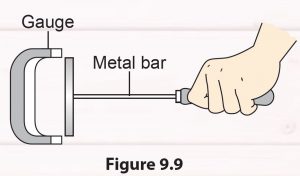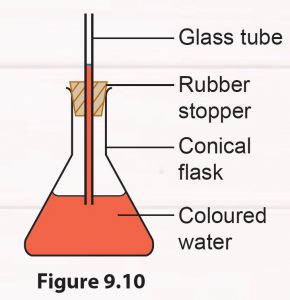Activity 9.4:
Aim: To show that heat can cause solid, liquid and gas to expand and contract.
(A) Solid
Apparatus: Bunsen burner, gauge and metal bar
Instruction
1. Try to fit the metal bar into the gauge (Figure 9.9).
2. Heat the end of the metal bar using a Bunsen burner for five minutes.
3. Try to fit the hot metal bar into the gauge. Record your observation.
4. Let the metal bar to cool and try to fit it into the gauge again. Record your observation.

(B) Liquid
Materials: Coloured water, ice cubes and hot water
Apparatus: Conical flask, basin, rubber stopper and glass tube
Instruction
1. Set up the apparatus as shown in Figure 9.10 and mark the coloured water level in the glass tube at the beginning of the experiment.
2. Place the conical flask into a basin of hot water and observe the coloured water level.
3. Repeat steps 1 and 2 by replacing the hot water with ice cubes and record your observations.

(C) Gas
Materials: Hot water, ice cubes and balloon
Apparatus: Conical flask and basin
Instruction
1. Set up the apparatus as shown in Figure 9.11.
2. Observe and record the condition of the balloon after three minutes.
3. Repeat steps 1 and 2. Replace the hot water with ice cubes.

Questions
1. Give an inference for your observation in Activity A.
2. Why is coloured water used in Activity B?
3. What causes the physical changes to the balloon in Activity C?
Answer:
1. The metal bar that has been heated cannot be inserted into the gauge because the metal bar has expanded.
2. Coloured water is used so that the change in the water level is easily visible.
3. Expansion and contraction of air inside the balloon cause the size of the balloon to change.
Aim: To show that heat can cause solid, liquid and gas to expand and contract.
(A) Solid
Apparatus: Bunsen burner, gauge and metal bar
Instruction
1. Try to fit the metal bar into the gauge (Figure 9.9).
2. Heat the end of the metal bar using a Bunsen burner for five minutes.
3. Try to fit the hot metal bar into the gauge. Record your observation.
4. Let the metal bar to cool and try to fit it into the gauge again. Record your observation.

(B) Liquid
Materials: Coloured water, ice cubes and hot water
Apparatus: Conical flask, basin, rubber stopper and glass tube
Instruction
1. Set up the apparatus as shown in Figure 9.10 and mark the coloured water level in the glass tube at the beginning of the experiment.
2. Place the conical flask into a basin of hot water and observe the coloured water level.
3. Repeat steps 1 and 2 by replacing the hot water with ice cubes and record your observations.

(C) Gas
Materials: Hot water, ice cubes and balloon
Apparatus: Conical flask and basin
Instruction
1. Set up the apparatus as shown in Figure 9.11.
2. Observe and record the condition of the balloon after three minutes.
3. Repeat steps 1 and 2. Replace the hot water with ice cubes.

Questions
1. Give an inference for your observation in Activity A.
2. Why is coloured water used in Activity B?
3. What causes the physical changes to the balloon in Activity C?
Answer:
1. The metal bar that has been heated cannot be inserted into the gauge because the metal bar has expanded.
2. Coloured water is used so that the change in the water level is easily visible.
3. Expansion and contraction of air inside the balloon cause the size of the balloon to change.